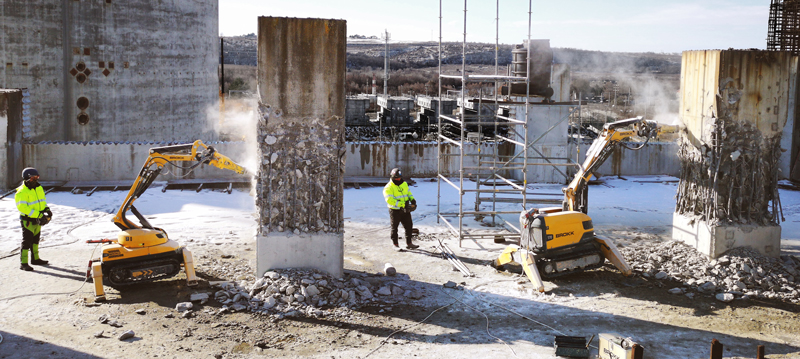Using Demolition Robots to Combat Labor Shortages

30 September 2021 News articles
In today’s competitive demolition market, methods that rely on manual labor are unsustainable. Instead, successful contractors are supplementing experienced crews with efficiency-enhancing machines for safer, more productive jobsites. Remote-controlled demolition robots allow contractors to move forward, despite ever-changing industry conditions, and pave the way for new opportunities. Here’s how remote-control construction equipment can make a difference.
Productivity Boost
Handheld pneumatic breakers and other highly physical methods have been commonplace on demolition jobsites for decades. However, taking a more mechanical approach and adding a remote-controlled demolition machine has allowed contractors to revolutionize productivity.
Thanks to advanced technology, demolition machines provide impressive hitting power, on par with excavators three times their size. Industry-leading power to weight ratios mean these compact machines can also access some of the most restrictive jobsites — including those with dust, vibration and noise restrictions as well as low floor loads. At 31 inches (79 centimeters) wide and weighing 1,235 pounds (560 kilograms), the most compact units are small enough to fit through standard doorways and light enough to be transported on passenger elevators, making them ideal for confined spaces and interior demolition projects. Larger models are also available for projects where power is more important than footprint.
By employing these heavy-hitting machines, contractors can greatly increase efficiency previously limited to large crews with handheld equipment. For example, one contractor was able to cut its demolition crew by one-third during a nearly 1-million-square-foot (92,903-square-meter), multi-level tear out. The two 2,183-pound (990-kilogram) demolition robots were able to access floors where even skid steers were deemed too heavy. With each demolition robot only requiring a single operator, the contractor was able to better utilize remaining employees across simultaneous jobsites while increasing productivity and lowering overall labor costs. This translated directly into more jobs, less overhead and a bidding advantage in a highly competitive demolition market.
Increased Safety
Demolition robots can also be found at the forefront when it comes to creating safer jobsites by removing operators from many of the most dangerous situations.
With an operating distance of up to 984 feet (300 meters), remote-control machines physically distance employees from harmful silica dust, as well as the strong vibrations of handheld equipment such as breakers, rivet busters and chipping guns. Long-term use of these common demolition tools is linked to a number of chronic injuries, including carpel tunnel syndrome, nerve damage and hand-arm vibration syndrome.
Additionally, remote-controlled demolition machines help prevent one of the most common causes of serious work-related injury and death in construction — falls. A remote-controlled unit allows operators to remain a safe distance from ledges and other fall hazards. This provides peace of mind for workers and project managers, but also increases productivity by minimizing the need for erecting fall protections.
For contractors using remote-controlled machines, these safety benefits can quickly add up to significant savings on workman’s comp and insurance premiums. Remote operation paired with smaller crew size can significantly lower worker liability costs by limiting personnel in confined spaces or hazardous operations. In the construction industry, one concrete cutting contractor who made the switch to demolition robots has seen a decrease in annual compensation claims by about 50. The company has also seen a 25% decrease, or about $40,000 – $50,000 savings, in injury costs per year. Another concrete cutting operation reduced its experience modification rate (EMR) by adding demolition machines to their equipment fleet. Insurance companies calculate EMR based on a company’s safety record. Higher EMRs result in higher insurance premiums.
Engaging Younger Workers
While demolition robots definitely provide a boost to the bottom line by reducing operating costs, contractors who have made the switch find the benefits go far beyond dollars and cents.
In today’s competitive job market, finding and retaining skilled workers has become a major challenge. At the heart of the labor shortage are two key factors — an aging group of current employees and fewer young workers interested in entering skilled trades. However, despite these shortages, the demand for demolition continues to grow in a variety of industries, leaving contractors with a perfect storm of plentiful work but not enough hands to carry it out.
Here again, mechanization offers an innovative solution. In addition to safety and comfort features that allow existing employees to remain on the job for longer, cutting-edge demolition equipment and robotic technology are attractive to younger workers. For one concrete cutting company, including advanced robotic technology in their fleet helped reduce the median age of their 300-strong workforce to just 25 years old and cut turnover 10%. The machines also allowed the contractor to do more work with fewer people, increasing productivity 17% over three years.
Crunching the Numbers
Remote-controlled demolition machines provide significant growth potential for contractors. Increased productivity opens up opportunities for consecutive projects and better workforce utilization while the machine’s unique capabilities offer the chance to expand into new markets and applications.
We can’t know exactly what tomorrow’s jobsite will look like, but factors such as productivity, safety and profitability will always be key factors to overall success. Mechanization allows forward-thinking companies to adapt to changes in labor, process or regulation, keeping them ahead of the curve — and the competition.
Stay updated!
Thank You!
Thanks for your message. We’ll answer as soon as possible!
// The Brokk team
